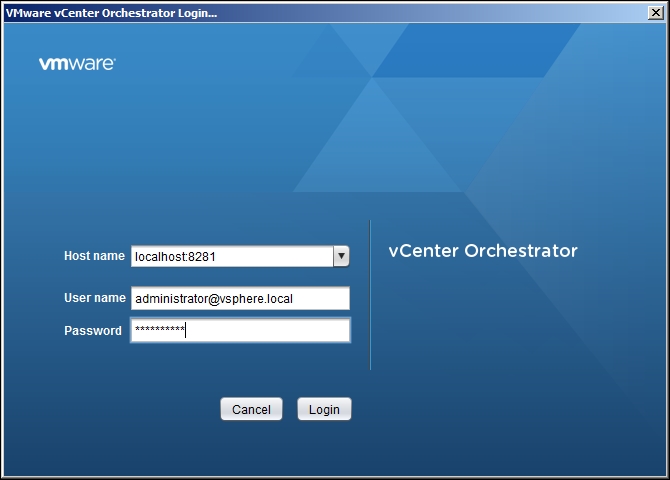In this recipe, we will get Orchestrator up and running using the Orchestrator version that is installed along with vCenter or vRealize Orchestrator.
You either need administrative access to the Windows OS of your existing vCenter Server (5.1 or higher) installation, or you need a functional vRealize Automation installation (see the introduction to Chapter 7, Working with VMware Infrastructure, for more information).
This recipe is not the same for vCenter-integrated and vRA-integrated Orchestrator implementations. There is a slight difference.
On your marks, get set, GO!
Follow these steps if you are using the vCenter-integrated Orchestrator.
Log in to the Windows OS of your existing vCenter installation.
Open the Services—for example, for Win 2008 R2, navigate to Start | Administrative Tools | Services.
Find the VMware vCenter Orchestrator Server service.

Right-click and select Start. If the service fails to start, have a look at the There's more... section of this recipe. The first start might take a while and Windows might complain about it, but just have patience.
When the service has started, use vCenter Orchestrator Client to connect to Orchestrator. You'll find the client by navigating to Start | VMware | vCenter Orchestrator Client.
Enter
localhost:8281as Host name,[email protected]as User name with the corresponding password, and click on Login.
Follow these steps if you are using the vRA-integrated Orchestrator:
Open a web browser and enter the IP or FQDN of the vRA appliance.
Click on the vRealize Orchestrator Client link.
Enter
[IP or FQDN of the vRA appliance]:8281as Host name,[email protected]as User name with the corresponding password, and click on Login.
Finished! Orchestrator is up and running.
When you install vCenter, you also automatically install Orchestrator; however, what you probably don't know is that the installer also configures Orchestrator to use the vCenter database, registers itself with SSO, and configures the vCenter plugin. Orchestrator is now easily accessible and fully configured to work with vCenter/vRA.
That said, one needs to understand that we have just started another hungry service on vCenter/vRA VM. As already discussed in the introduction, you might want to rethink this.
Looking at how the vCenter-integrated Orchestrator is configured, we find that the whole configuration process is triggered by the vco.properties file in the C:\Program Files\VMware\Infrastructure\Orchestrator directory. It contains all relevant information, but no passwords.
If you look into Orchestrator's configuration using the Orchestrator Configuration tool (see the Two ways to configure Orchestrator recipe in this chapter), you will find the following configurations:
In the Network section, the vCenter and the SSO SSL certificates have been added.
In the Authentication section, SSO is configured. If we log in to the SSO server, we find an existing group called vCOAdministrators and that the administrator (@vsphere.local) is a member of this group. We also find that Orchestrator is registered as an application user.
In the Database section, there is a new and unique database type: vDB. This is a connection to the ODBC drivers you set up for vCenter.
In the Licensing section, Orchestrator has been licensed with the vCenter license key.
Last but not least, the vCenter plugin is configured with vCenter details.
This all makes the vCenter Orchestrator installation the most easy to use for beginners. Basically, you only have to start the Orchestrator service on vCenter Server and you are ready to go.
If you get an error while starting the Orchestrator service, have a quick look at C:\Program Files\VMware\Infrastructure\Orchestrator\app-server\logs. There is a file called server.log. This is the logfile for the Orchestrator service. The most common problem at this point is that the database cannot be accessed. If this is the case, I would recommend switching the database type to embedded.
To fully integrate Orchestrator into your vCenter, continue with the Integrating Orchestrator into SSO and vSphere Web Client recipe in this chapter as well as the recipe Orchestrator and vSphere Web Client in Chapter 5, Basic Orchestrator Operations.



